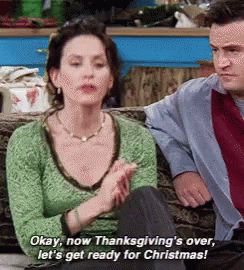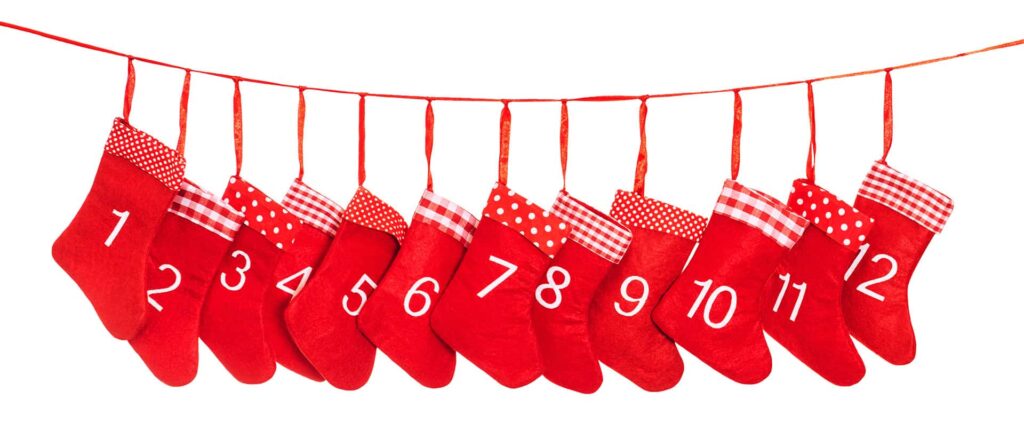The nights are closing in, there’s frost on the windows, and everyone’s picking out their favorite novelty jumper. Yes, it’s that time of the year yet again: Christmas. To go with that cold weather, we’ve got a new batch of cold sales lessons, fresh from the oven, that you can apply year-round.

9 Cold Sales Stories From Christmas
The man who cut down his tree

“I’ll have to call you back. I’m in the middle of a field cutting down a tree.”
That was the message I had when I tried calling a friend up last week.
The next day he explained what had happened. When it comes to the Christmas tree, he isn’t happy with a fake one, or even a real one from the shops. Each year, he goes out to a ‘tree farm.’ He picks the tree he wants, cuts it down by himself, then drags it a couple of kilometers back to his truck.
Then he does it all over again, for his mother-in-law.
To most people, that’s madness. Why would you go to all that time and trouble, just to get a tree that’ll sit in your house for a few weeks and make a mess? However, to my friend, it’s absolutely worth the extra hard work.
Imagine trying to sell a plastic Christmas tree to my friend.
If you were treating him like most people, you might talk about the benefits of a tree that you can pack up and reuse every year, with no mess and no fuss, but none of that matters to him. All he cares about is the authentic experience.
To the average man on the street though, if you tried telling him he could pay more for a tree that he’ll have to get rid of in a few weeks and tidy up after, he wouldn’t give you the time of day. There are so many factors that go into a simple decision like what Christmas tree you’re going to have: Authenticity. Environmental impact. Convenience. Cost. The importance of each factor will completely vary from person to person.
The point is, whether you’re selling Christmas trees or accounting software, you need to be selling the right product to the right prospect.
There’s no point selling an enterprise-level accounting solution to a solo freelancer, and there’s no point selling your budget DIY account app to one of the Fortune 500. This means having a clear picture of your ideal customer and focusing on them.
Lesson: Make sure you’re selling the right product for the right prospect
‘Tis the season

Ah, the Christmas season. Festive lights all over the house, mince pies on the table, and snow on the ground (at least in the northern hemisphere). With this season comes sales opportunities. The sellers of Christmas lights, mince pies, and snow blowers go into overdrive.
Of course, Christmas isn’t the only season out there. Flowers sell more in spring and ice cream sells more in summer. The chances are, whatever it is you’re selling, it has its seasonal variations too. That accounting software you’re selling will be in massive demand when companies are filing their taxes. The day after, it’ll be at the bottom of their to-do list.
At this time of the year, your customers may already be winding down for the year, or they could be working flat out to hit those crucial Q4 quotas (we are!). They may be eager to hear about your solution, or they couldn’t care less.
The important thing is to recognize those variations and optimize for them. Understand you’ll never sell as many mince pies in summer.
Lesson: Be aware of any seasonal variations in demand for your product, and adjust your sales properly.
The 12 days of outreach

Whether it’s playing in the shopping mall or you’ve had carolers at the door, you’ve probably heard ‘The 12 Days of Christmas.’
For each of the 12 days, the person’s true love sends them a different must-have present, such as a partridge in a pear tree, some lords a leaping, and a PS4 (or that last one may have been wishful thinking). The point is clear: If you love someone, you better send an elaborate set of gifts over multiple days.
Okay, maybe that’s not the main message, but there’s still an important lesson for sales. Are you relying on just your one partridge in a pear tree, or do you have a full 12 days of different gifts? In other words, are you relying on a single message in a single channel? Or are you using different channels to send multiple messages?
Your prospects no longer rely on just phone calls or emails.
They’re active in lots of different channels and are going to be more ready to listen and engage in some channels than others. One of your prospects may never pick up their phone but would react positively to a personalized video message.
Another may ignore their inbox but be happy to start a conversation on social media. Rather than trying to guess which channel is the best though, create a multi-channel campaign that will grab their attention.
Lesson: Send multiple messages in different channels.
The Christmas movie with John McClane

The winter season is not without its controversies, the biggest of which is surely whether or not Die Hard is a Christmas movie or not, a point plenty of people will happily argue over to their last breath—you’ve got to love the internet.
As far as I’m concerned, there’s no argument. It’s definitely a Christmas movie, just with more action and a prettier Santa.
However, those who are against Die Hard being entered into the Christmas movie hall of fame argue that to qualify as a true Christmas movie, a movie should have a ‘Christmassy’ theme throughout.
The core of the movie should reflect the values associated with Christmas (which apparently doesn’t include liberating the oppressed hostages from Nakatomi Plaza). Just because a movie takes place at Christmas, that isn’t enough to make it a Christmas movie.
When it comes to cold sales, we all know there’s important content we should include in our outreach. We need to offer value. We need to try and start a conversation. However, you cannot just slap a half-baked value prop in your email and say that makes it a ‘value-packed’ email.
You can’t just stick ‘Let me know what you think’ at the end of your message and say you’re engaging with your prospect. These are critical points and should form the foundation of your entire message.
Is your email a Christmas email? Or is it just sent at Christmas? Yippee-ki-yay indeed.
Lesson: Don’t just pay lip-service to value and engagement; make them the core of your message.
Bonus: For more tips on creating a compelling message, check out our resource of 20 email outreach templates.
The elf who wrapped all the presents

Who first thought of the idea of wrapping presents? Who said, “You know what will make this pair of socks even better? Wrapping them in shiny novelty paper!”
I don’t know who, but they were a genius. Wrapped presents are mysteries, building anticipation and making the whole process more exciting, transforming the dull to the extraordinary.
How you frame and position your product or service is critical. Plenty of great businesses offered a valuable product but ended up failing because they didn’t know how to wrap that product up in a pretty bow.
Unfortunately, it takes a little bit more than some cheap paper to properly frame your offer. First of all, you’ll need to consider your audience and what matters most to them. Remember our first story: do they want a real Christmas tree, or do they want a plastic one? Once you know what’s important to them, you need to make sure your messaging emphasizes the benefits that your prospects actually care about.
It’s the difference between a car with a 968 hp, and the most powerful Ferrari on the road that will leave everyone else in the dust.
Both statements are accurate, both refer to the same car, but one creates a much more appealing image to the right person. One offer is plain, the other is wrapped up in its benefits.
Lesson: Wrap up your sales messaging to be as appealing as possible to your prospect
The dad who tried cooking the turkey in a microwave

Even if you’re the biggest scrooge who hates everything to do with Christmas, I guarantee there’s someone who hates it more: Turkeys. They don’t have it easy this time of year, what with being the meal of choice for both Thanksgiving and Christmas.
Still, if you’ve ever been the one responsible for cooking that turkey on December 25th, you’ll know there’s a lot of pressure to get it right. No matter how many Youtube videos you watch, cooking a turkey with all the trimmings isn’t something you can just throw together. To get it right, you need to prepare, and you need plenty of time.
With all the advice out there, it’s easy to think that anyone can put a winning sales email together in a couple of minutes, then sit back and watch the orders roll in. Unfortunately, reality doesn’t work that way.
First, you need to prepare. You need to know your customers so well that you can say what keeps them awake at night. Even when you’ve got all the ingredients ready, you still need to give it time. The best turkey is still going to leave a seriously bad taste if it’s served half-cooked.
It doesn’t matter if your offer is perfect for your prospect, they’re not going to buy anything from a stranger. Especially for big-ticket items, people need to establish trust before they hand over their hard-earned money. Build your outreach campaign around engaging with your prospect, nurturing them and building a genuine relationship.
Lesson: Cold sales takes time and preparation to get the best results.
The traditions that made Christmas

We’ve already talked a lot about some of the Christmas traditions. Whether it’s having the perfect tree in the corner of your living room, watching Die Hard with your friends, or a turkey dinner that’ll feed a small city, we all have traditions that we look forward to.
It’s not just for Christmas though. Most people, if you ask them, will claim they prefer new experiences, that they like to change things up.
What they really want is the familiar. We’ll stick to the same takeaway options, we’ll go and see the superhero sequel, and order the same drink at the bar. In a world that offers almost infinite choices, we keep making the same ones.
It’s important to recognize how much our brains subconsciously affect sales decisions. Steve Jobs famously wore the same outfit all the time because he recognized making decisions takes brainpower. As a result, we save brainpower where we can by making the same default decisions.That makes traditions incredibly powerful.
When we start to sell, it’s easy to focus on our offer’s new and unique features.
How many times have you heard someone describe their product as ‘revolutionary,’ something that’ll transform the industry forevermore? But do people really want a revolution? Or do they want what they know? Henry Ford is famously attributed as saying that if he’d asked people what they wanted, they would have said faster horses.
This isn’t to say there should never be any revolutionary products, or that we shouldn’t highlight our offer’s innovations. Rather, it’s important to relate your product to something your prospect already knows. Don’t paint them a picture of a future they can’t imagine; draw them a familiar picture that includes your product.
Lesson: Make your offer a safe bet, not a revolutionary tradition-buster.
The unique holiday

Okay, this might seem like it’s the complete opposite of our last story, but hear me out. Yes, we all want our traditions, our familiar comforts, but they must be our traditions, not someone else’s.
What this time of year means to you is going to be different to what it means to other people. Your idea of the perfect Christmas might be being with your family, sitting around a roaring log fire. Others might prefer to go out and party all night. You might celebrate Christmas, Hanukkah, something else, or nothing at all. Either way, you do you.
Just because you’re aware of what most people want, that doesn’t mean you know what every person wants. We’re all unique snowflakes, and forgetting that is a big mistake in sales. I blame our obsession with data. Data is awesome and it can help us make better decisions, but the second we start looking at our prospects as nothing more than entries in our CRM, we lose out.
Genuinely engage with your leads. Find out what’s important to them specifically, what problems they’re facing, and what they’re looking for in a solution. If you ignore that engagement and rely purely on the data, that’s when your messages start sounding like a robot.
Lesson: Engage with your prospects as unique people, not data points.
The gifts that touched the heart

I don’t know a single person who doesn’t enjoy getting a gift, especially one that’s heartfelt and clearly been picked just for them (and yes, I really would appreciate a heartfelt PS4).
Most of us also enjoy giving gifts, but it comes with a lot of pressure. Is it something they’ll like? Have they already got this? Will they use it and appreciate it, or will they want the receipt so they can exchange it?
When you’re selling, it’s important to provide value. We all know this. As we’ve already discussed, we can’t just slap the word value in our email and call it a day. That’s the equivalent of giving them another stationary set they’ll never use (I don’t care how grateful a person seems, nobody really wants a stationary set as a present. Don’t @ me).
Instead, you need to carefully think about what value you’re going to give out in your outreach, as carefully as if you were picking out a gift for your prospect.
First of all, that means thinking about what they want and need, not what’s easiest for you to give. It also means thinking about what they already have. If your big value offer is a weekly newsletter, chances are they already have plenty of newsletters clogging up their inbox.
However, if you offer them a cheat-sheet full of helpful tips and tricks to make their job easier (not something you’ve just copied off another site), you’re more likely to make an impact.
Lesson: Give your prospects something they’ll actually value in your emails.
There we go, nine lessons for sales for you to think about over the holidays. Whatever you have planned, one last request: take some time to forget about work, to recharge your batteries and most importantly, have some fun! See you in the new year!
Before you go, don’t forget your gift! We’re constantly working on improving and optimizing Reply; this year we added support for multi-channel sequences and new functionality for cloud calls and video-based emails.
Subscribe to our blog to receive the latest updates from
the world
of sales and marketing.
Stay up to date.



![Upselling and Cross-selling: The Go-To Guide [+7-Step Framework Inside] Upselling and Cross-selling: The Go-To Guide [+7-Step Framework Inside]](https://reply.io/wp-content/uploads/upsale-1024x538.jpg)

